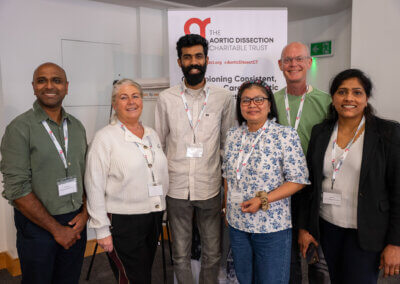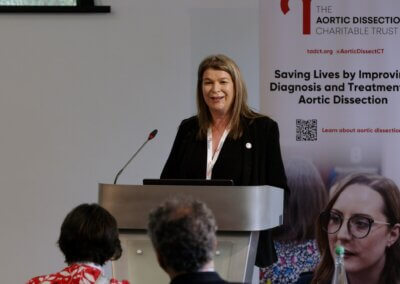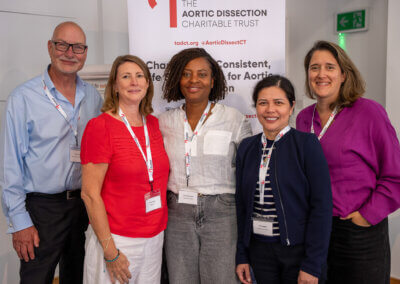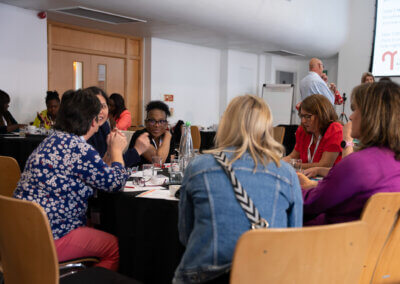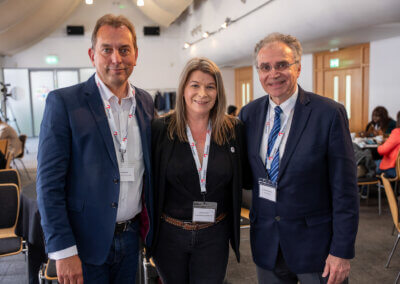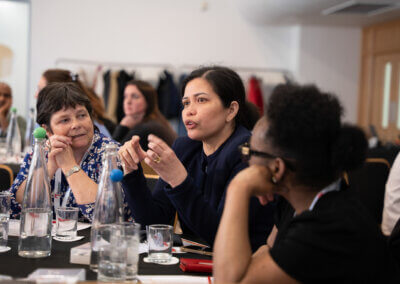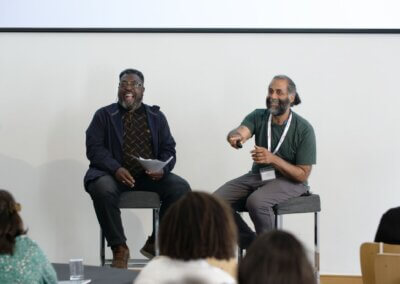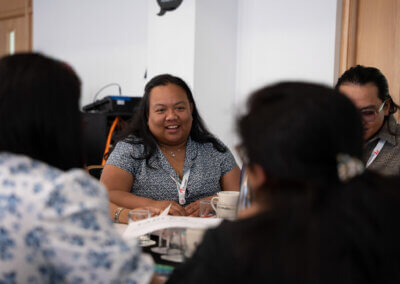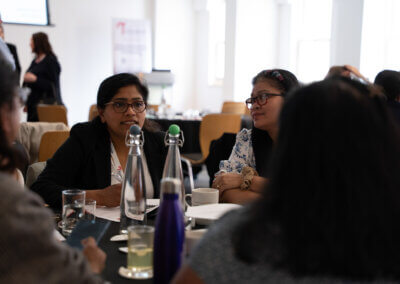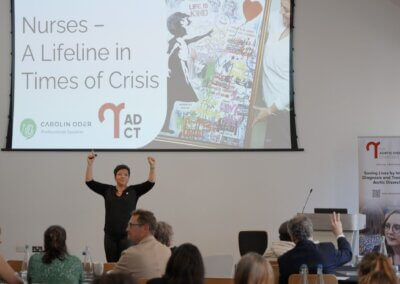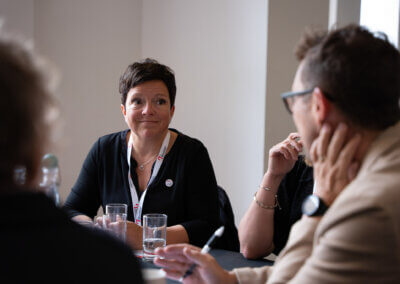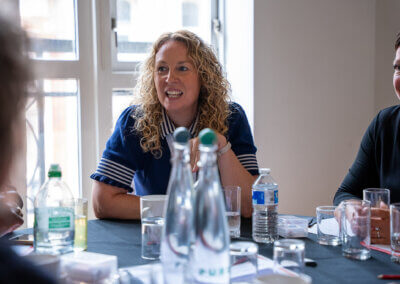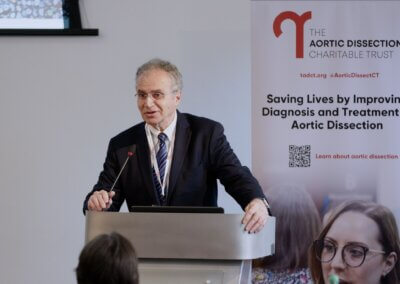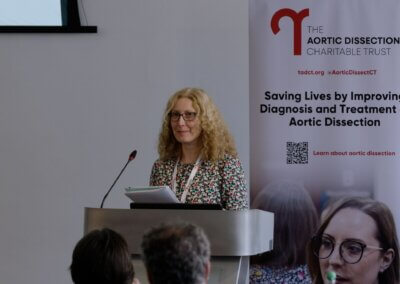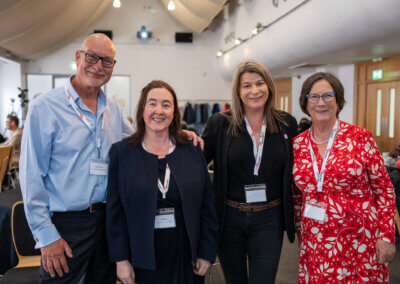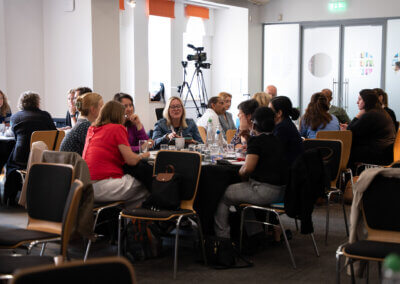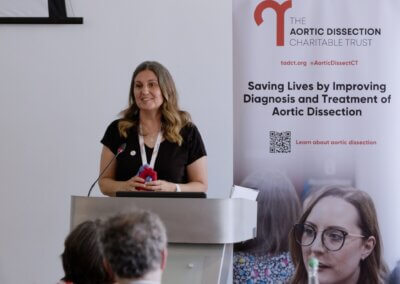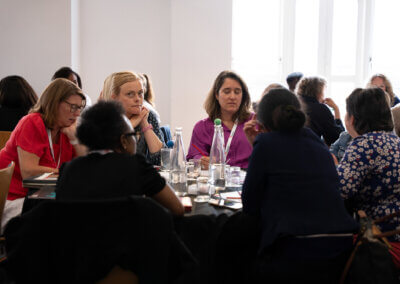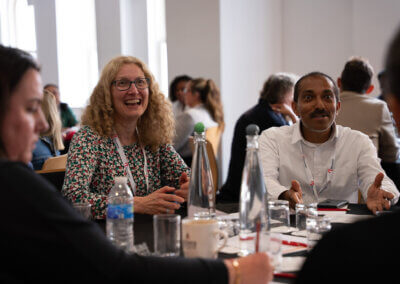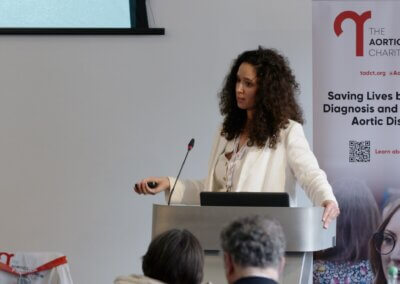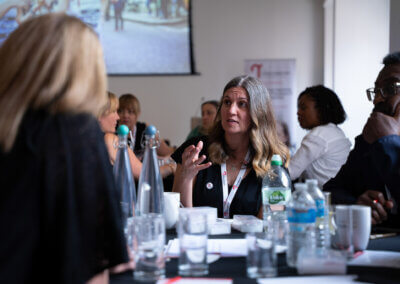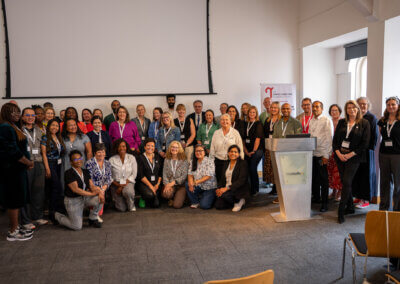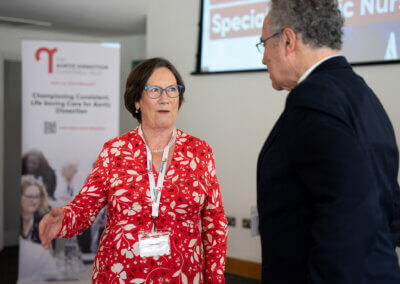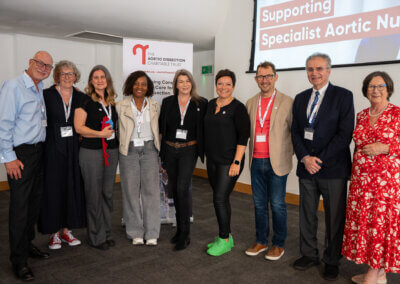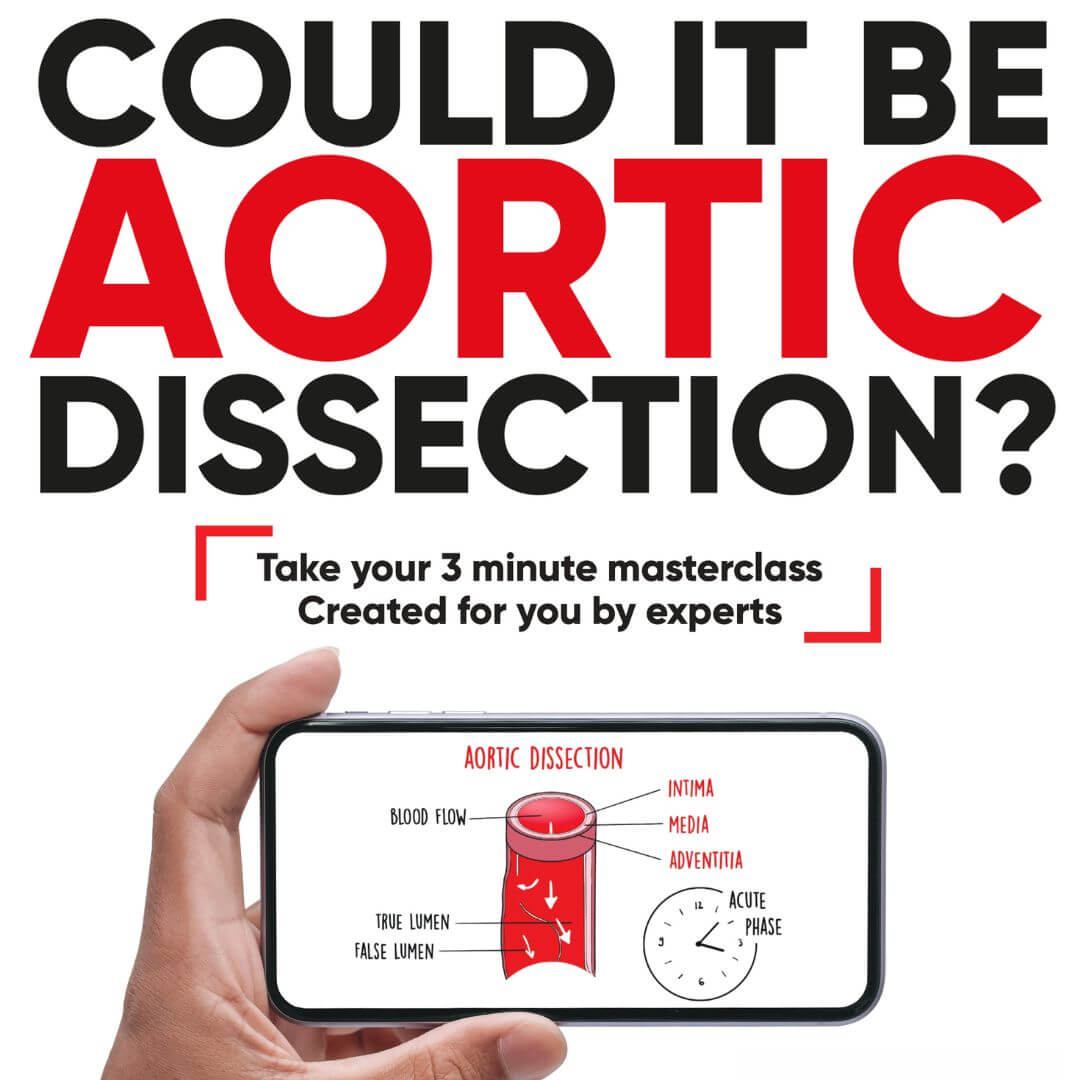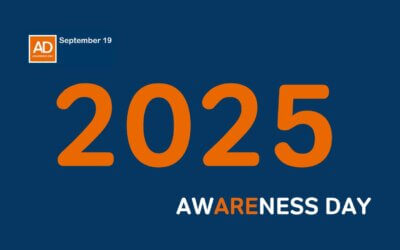The Aortic Nurses Symposium, held in Birmingham this year, brought together a diverse group of nursing professionals committed to advancing care for patients with aortic dissection and related conditions. From those exploring specialisation in aortic care to nurses leading established clinics, attendees gathered to share knowledge, build networks, and hear directly from patients about the impact of dedicated, informed support. The symposium offered an important platform to strengthen best practice, promote collaboration, and continue shaping a future where every patient has access to expert aortic care.
The Patient Perspective
The symposium began with a heartfelt welcome from Michael Kyriakides, the charity’s newest trustee and an aortic dissection survivor. Michael shared his personal journey, from the moment of diagnosis through surgery and recovery, highlighting the critical gaps in care following discharge from hospital. While he acknowledged the excellence of acute NHS treatment, he emphasised the challenges faced once patients return home. Challenges that are often invisible to the system.
I do think we can do many things to help the experience of both the families who are going through the journey and the patients themselves, and I think aortic nurses can have a key role in driving that forward.
Michael Kyriakides, Aortic Dissection Patient & Charity Trustee
Michael spoke about the complex emotional and physical recovery process and how difficult it was to navigate without structured support. He identified areas where aortic nurses can make a significant difference, particularly in patient education, follow-up care, and reintegration into daily life. His reflections pointed out the importance of specialist roles in improving long-term outcomes and ensuring patients are not left to manage alone.
A Vision for the Aortic Nurse Specialist
The symposium welcomed insights from Maryann Babcock, widely recognised as one of the first dedicated aortic nurse coordinators, and Dr John Elefteriades, William W.L. Glenn Professor of Surgery at Yale University. Speaking via video, Maryann reflected on her decades of experience, emphasising the pride and purpose found in aortic nursing. She encouraged attendees to recognise the impact of their work and to seek out those with a natural interest in aortic care to grow the specialty.
The aortic nurse coordinator needs to be comfortable in all environments: CT, echo, ICU, the OR and must be unperturbable under pressure.
Dr John Elefteriades, William W.L. Glenn Professor of Surgery at Yale University
Dr Elefteriades offered a comprehensive vision for the aortic nurse specialist, drawing on over 30 years of clinical practice and innovation. He outlined the essential qualities of a nurse coordinator: resilience, multidisciplinary fluency, and a strong patient-centred ethos. Through vivid examples, including surgical footage and landmark research, he demonstrated how nurse-led observations had contributed to major advances in understanding aortic disease, such as the risks of weightlifting and the genetic inheritance of aortic conditions.
His message was clear: the aortic nurse is a cornerstone of effective, modern aortic care. From coordinating across specialisms to guiding patients and families through complex pathways, the nurse specialist holds a unique and irreplaceable role in improving outcomes and shaping the future of the field.
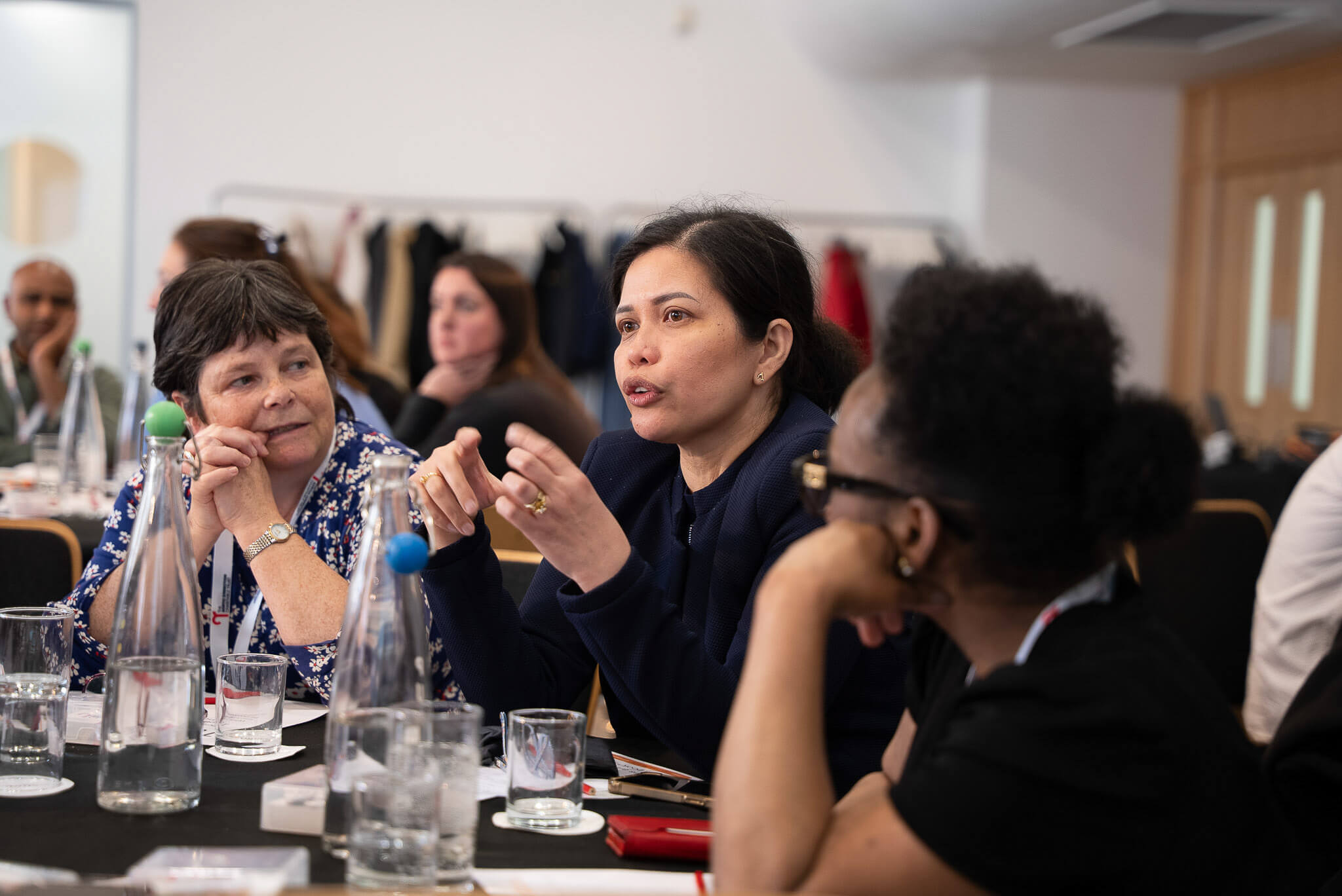
Genetic Screening in Aortic Dissection
The session on genetic screening was led by Dr Deborah Osio, Consultant in Clinical Genetics at Birmingham Women’s Hospital, and Emily Mickleburgh, a family member of two aortic dissection survivors. Dr Osio delivered an extensive overview of the genetic basis of thoracic aortic aneurysms and dissections, underlining the significance of early diagnosis, syndromic and non-syndromic inheritance patterns, and the UK’s national testing infrastructure. She outlined how genetic screening can inform clinical decisions, influence surgical thresholds, and identify at-risk relatives who may benefit from surveillance or intervention.
When a patient presents with an aneurysm or a dissection, it can be an early warning that other family members may be at risk.
Dr Deborah Osio, Consultant in Clinical Genetics at Birmingham Women’s Hospital
Emily then gave a powerful personal account of navigating the condition within her own family. Her mother and sister both survived acute dissections, yet the process of understanding the hereditary risk and coordinating care was fraught with uncertainty and lack of information. She spoke candidly about missed opportunities for support and the need for compassionate, accessible contact points, particularly from aortic nurse specialists, who could guide families through complex clinical landscapes. Her story illustrated the human side of genetic risk, and the vital role that dedicated professionals can play in demystifying and managing inherited aortic disease.
Being told I might be a ticking time bomb was terrifying, but it also started my journey to understand and protect my family.
Emily Mickleburgh, Aortic Dissection Family Member
The Liverpool Aortic Clinic Model
Professor Mark Field, Consultant Aortic Surgeon, presented the comprehensive nurse-led aortic service developed at Liverpool Heart and Chest Hospital, supported by Aortic Advanced Practitioner Úna Ahearn. Their service demonstrates how sustained investment in multidisciplinary collaboration can deliver effective, patient-centred care across the full spectrum of aortic disease.
Professor Field outlined the structure of the clinic, stressing that while Úna runs independent nurse-led clinics, she is embedded within a wider team of consultants, fellows, and allied specialists who support real-time decision-making. The service includes dedicated pathways for genetic conditions, thoracoabdominal aneurysms, and complex dissection cases, with an emphasis on first contact and continuous follow-up. The model also incorporates a new “hot clinic” for post-operative and medically managed dissections, aiming to standardise follow-up care and reduce gaps in support.
To my mind there are two drivers that are driving change in treating patients with aortic dissection: the aortic dissection toolkit and the charity. These are really the people that are advocating on behalf of patients.
Prof Mark Field, Consultant Aortic Surgeon, Liverpool Heart and Chest Hospital
Úna’s role extends beyond the clinic room. She leads on patient education, consent for genetic screening, coordination of multidisciplinary meetings, and the management of complex referral and imaging workflows. Her ability to interpret scans and deliver targeted care is underpinned by rigorous governance and competency frameworks developed within the Trust. The Liverpool experience demonstrates how an advanced nurse practitioner can be central to delivering safe, scalable, and specialist aortic care.

Life After Aortic Dissection
Alice Lopes, Vascular Aortic Fellow at Barts Heart Centre, joined patient advocate and triathlete Martin Hilton to lead a dynamic session on navigating life after aortic dissection. With a focus on adaptation rather than limitation, they explored common post-discharge challenges and the evolving role of clinicians in guiding patients through recovery.
Alice stressed that while recurrence of dissection is rare, ongoing management is essential. Patients need lifelong blood pressure monitoring, consistent medication, and regular imaging. The transition from hospital to home is often when patients feel most uncertain, and this is precisely where aortic nurses can provide continuity, helping individuals interpret symptoms, manage expectations, and avoid unnecessary anxiety.
Most of the time, a simple ‘yes’ or ‘no’ isn’t enough. Patients need to understand the ‘why’ behind it, especially when their lives have just changed so dramatically.
Alice Lopes, Vascular Aortic Fellow at Barts Heart Centre
Martin’s personal reflections brought emotional clarity to these themes. Once a high-level endurance athlete, he described the disorientation of waking from surgery with little understanding of what lay ahead. His journey back to fitness, culminating in completing 630-mile coastal trek, was made possible not just by determination, but by the guidance of clinicians who listened and adjusted care accordingly. Together, he and Alice discussed key lifestyle adjustments, including the importance of aerobic exercise, the need to avoid blood pressure spikes from heavy lifting, and the emotional complexity of returning to sexual activity and daily life.
Both speakers addressed the psychological toll of dissection. Patients often grieve their former selves, while family members carry their own burden of trauma. Honest conversations about medication, work, travel, and mental health were championed as vital to recovery. Alice reminded attendees that these concerns are often Googled rather than voiced, and it is the responsibility of aortic professionals to create safe, supportive spaces for these discussions.
Martin’s message resonated: with the right support, patients can rebuild their lives, not as a shadow of what they once were, but with a renewed sense of purpose and perspective.
Nurses as a Lifeline
The keynote session was delivered by Carolin Oder, speaker, author and podcast host, who shared a deeply personal and moving account of life as the mother of a child with Loeys-Dietz Syndrome. Travelling from Zurich, Carolin detailed her family’s harrowing journey through over 20 surgeries, including her son’s type B aortic dissection at just nine years old.
Her talk focused not on clinical data, but on the profound emotional and psychological impact of serious illness, and the role nurses play in shaping how families experience crisis. Through stories of honesty, connection and compassion, Carolin described how individual healthcare professionals became lifelines during her family’s darkest moments. One ICU doctor earned her lasting trust by admitting vulnerability and offering honest reassurance. Another brought empathy simply by placing a hand on his heart and acknowledging the family’s pain.
You are empowered to make a difference in your patients’ and families’ lives. Please don’t forget that.
Carolin Oder, Author and Podcast Host
Carolin’s framework outlines seven strategies for navigating trauma. She spoke on three: Acceptance, where trust and human communication allow families to face the unchangeable; Emotion, where professionals who empathise and show humanity enable patients and relatives to feel safe; and Optimism, which can be sustained through humour, gratitude and visualising the best possible outcome, even in moments of acute fear.
Her message was a powerful reminder that technical skill alone is not enough. By choosing to connect with patients as people, nurses become much more than caregivers, they become stabilising forces in times of overwhelming uncertainty. Carolin’s closing words were clear: nurses are empowered to make a difference, and in doing so, they bring strength and dignity to even the most fragile circumstances.

Controlling Blood Pressure in Aortic Disease
Dr Vikas Kapil, Consultant in Cardiovascular Medicine at Barts Heart Centre, and patient advocate Ray Barrett delivered a practical and candid session on managing blood pressure after aortic dissection. Their discussion combined clinical insight with personal experience, highlighting the importance of clear communication, consistent monitoring, and shared decision-making.
Ray recounted his experience of three major aortic surgeries across different hospitals, starting in 2007. His story highlighted the ongoing challenge of inter-hospital communication, as well as the lack of follow-up, with no specialist review since his last operation in 2022. Dr Kapil used this as a springboard to reflect on the need for robust systems that prevent patients from falling through the gaps, despite high-quality surgical care.
I had 16 days in a coma, had to learn to walk again… then 13 months of rehab before I could get back to work. I’ve had three operations and survived them all. Don’t let me fall through the cracks now.
Ray Barrett, Aortic Dissection Patient
The core of the session focused on blood pressure monitoring. Dr Kapil recommended semi-continuous home measurements, ideally three days per week, with three readings taken morning and evening. He explained how proper technique, validated equipment, and correctly sized cuffs are essential to ensure reliable readings.
Ray shared his approach to monitoring and his uncertainty about targets. Dr Kapil outlined clear, evidence-informed thresholds: a home blood pressure of less than 130/80 mmHg is generally the goal, with lower targets for those with residual dissection or genetic conditions. He also introduced a monitoring app used at Barts, which enables two-way communication between patients and their care team.
Medication management was also discussed in detail. Ray takes five antihypertensive medications, and Dr Kapil walked through the rationale for each class, including beta blockers, ACE inhibitors, calcium channel blockers, diuretics, and alpha blockers. Particular attention was given to the importance of tailoring therapy, managing side effects, and recognising that achieving blood pressure control is a collaborative process, not something imposed upon patients.
Lifestyle advice rounded off the session. Dr Kapil promoted a “happy monk” model, emphasising vegetables, moderate exercise, mindfulness, social connection, and sustainable habits. His final message was clear: with the right knowledge and support, patients can take control of their blood pressure and significantly reduce their long-term risk.

Driving Forward
The Aortic Nurses Symposium saw delegates engage in dynamic roundtable discussions, bringing together frontline experiences and fresh thinking on how to strengthen aortic care across the UK and Ireland. Conversations ranged from overcoming systemic barriers to establishing sustainable, patient-centred services led by specialist nurses.
A recurring theme was the need for clarity, both in clinical pathways and in professional roles. Nurses called for better integration between cardiac and vascular teams, alongside more targeted education and collaboration. Clearer definitions of the cardiovascular nurse’s scope and more focused multidisciplinary meetings were proposed to support this aim.
Participants also reflected on the structural challenges they face, limited capacity, fragmented services, and insufficient discharge planning were highlighted as critical areas needing attention. The NHS toolkit was widely welcomed, and many looked to it as a foundation for developing consistent care standards, particularly in the transition from acute treatment to lifelong management.
Several tables addressed the business case for aortic nurse specialists, urging that arguments be grounded in outcomes, efficiency, and safety. Delegates shared examples of how these roles free up consultant time, improve patient satisfaction, and reduce emergency admissions. Peer support, accessible resources, and better mental health care for patients were identified as essential complements to clinical work.
There was strong consensus on the value of a national scope of practice for aortic specialist practitioners, one that encompasses acute care, genetic screening, rehabilitation, and community follow-up. Delegates advocated for formal training in imaging interpretation, enhanced cross-hospital communication, and a unified digital network to improve continuity of care.
The day closed not with finality, but with momentum. The Community of Practice stands as a growing hub for knowledge exchange, innovation, and mutual support. Nurses left with a renewed sense of purpose and the connections, tools, and ambition to build a future where every patient facing aortic disease receives not just treatment, but true care.

